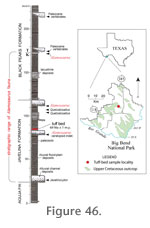|
|
|
AGE OF OJO ALAMO SANDSTONE BASED ON ALAMOSAURUS SANJUANENSISSullivan, Boere, and Lucas (2005, p. 580) stated that the age of the sauropod dinosaur A. sanjuanensis is precisely 69 Ma throughout the Western Interior of North America, including the San Juan Basin. They stated that this finding was based on an abstract by McDowell et al. (2004) that reported a U/Pb age of 69 ± 1.0 Ma for a tuff bed found in about the middle of the Javelina Formation in the Big Bend area of Texas. This assertion that Alamosaurus is exactly 69 Ma (near the Campanian-Maastrichtian boundary) represents a serious challenge to the findings in this report that the Ojo Alamo Sandstone is Paleocene in age because Alamosaurus fossils are found at several localities within the Ojo Alamo in the San Juan Basin. Because the McDowell et al. (2004) abstract is cited by Sullivan, Boere, and Lucas (2005, p. 580), as the basis for their claim that Alamosaurus is 69 Ma, a careful evaluation of this abstract is critical to an assessment of their claim. McDowell et al. (2004) stated that Maastrichtian vertebrates from the Western Interior occurred in two faunal provinces: the Triceratops fauna in the north and the Alamosaurus fauna in the south. It is thus clear that they were stating that these two faunas are the same age: Maastrichtian, or latest Cretaceous. These authors go on to say that their dated tuff bed is from the middle of the Javelina Formation and that: This position is within the local range of the sauropod Alamosaurus, below two sites that have yielded remains of the pterosaur Quetzalcoatlus, and above a site with petrified logs of the dicot tree Javelinoxylon. The range zones of all three taxa span the full thickness of the Javelina Formation elsewhere in the Big Bend region. The Alamosaurus Fauna is therefore Lancian to late Edmontonian in age. [My emphasis] It is thus clear that Sullivan, Boere, and Lucas (2005) misinterpreted the McDowell et al. abstract when they concluded that it found that the 69 Ma tuff bed represented the exact age of A. sanjuanensis. Sullivan, Boere, and Lucas (2005, p. 580) continued their discussion by stating that A. sanjuanensis has been reported to have a long range —from late Campanian to late Maastrichtian— undermining its value as an index fossil. Following this accurate statement, these authors proceeded to present arguments purporting to show that A. sanjuanensis in the North Horn Formation does not really range to upper Maastrichtian but is "pre-late Maastrichtian". These arguments are unconvincing because they contradict a large body of data supporting a late-Maastrichtian age for the A. sanjuanensis-bearing part of the North Horn Formation (Cifelli et al. 1999, Difley and Ekdale 1999). In Sullivan, Lucas, and Braman (2005), the conclusions of the Sullivan et al. (2005) report, regarding the 69 Ma age of A. sanjuanensis, were extended with the creation of the "Alamosaurus datum" (p. 401 and figure 7); these authors claim that this datum can be used to date the Alamosaurus level precisely at 69 Ma throughout the Western Interior including within the North Horn Formation of southeast Utah, the lower part of the Ojo Alamo Sandstone in the San Juan Basin, and the Javelina Formation in the Big Bend area.
Lehman et al. (2006) discussed
Lehman et al. (2006, p. 925) discussed the range of Alamosaurus and stated: Hence, introduction of the Alamosaurus fauna in southern North America must have occurred sometime after about 73 Ma but before 69 Ma, and so probably not coincident with the Edmontonian-Lancian faunal transition observed in northern locales. Furthermore, although it seems likely that the Alamosaurus fauna persisted to the end of Cretaceous time (ca. 65 Ma), this has yet to be demonstrated conclusively. Some evidence suggests that the Alamosaurus fauna may have persisted into Paleocene time (Fassett et al. 2002). The work of Lehman et al. (2006) thus contradicts the assertion of Sullivan, Boere, and Lucas (2005) and Sullivan, Lucas, and Braman (2005) that there is an "Alamosaurus datum" with a precise age of 69 Ma in the Big Bend area of Texas. Because the presence of Alamosaurus in the lower part of the Ojo Alamo Sandstone does not precisely date the base of the Ojo Alamo at 69 Ma, as suggested by Sullivan, Lucas, and Braman (2005), the presence of this dinosaur in the Ojo Alamo in no way refutes the Paleocene age of this formation. |
|
